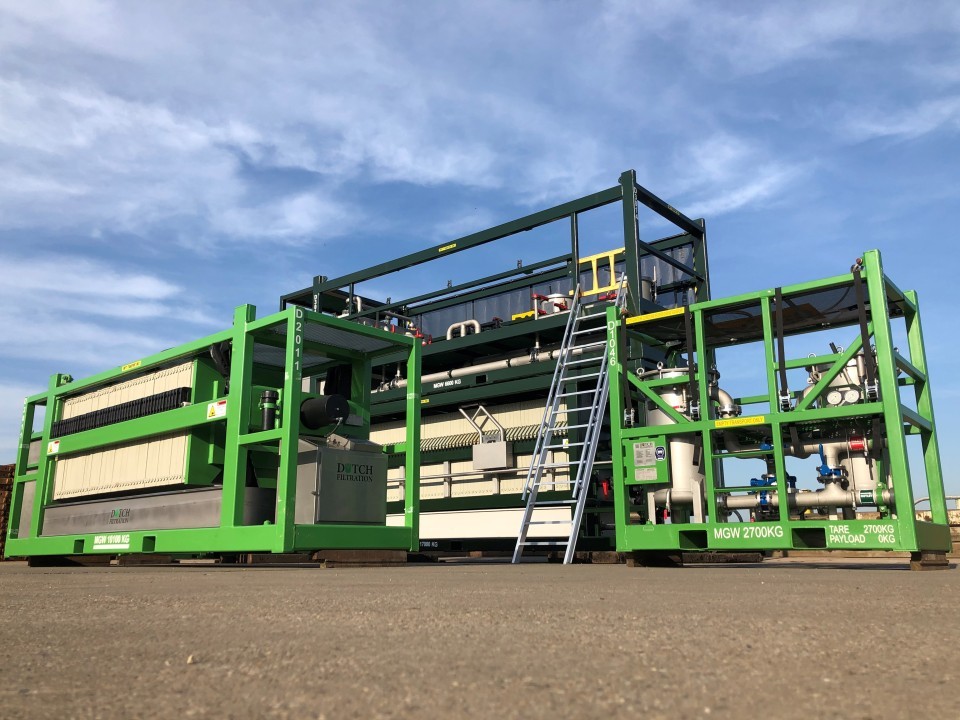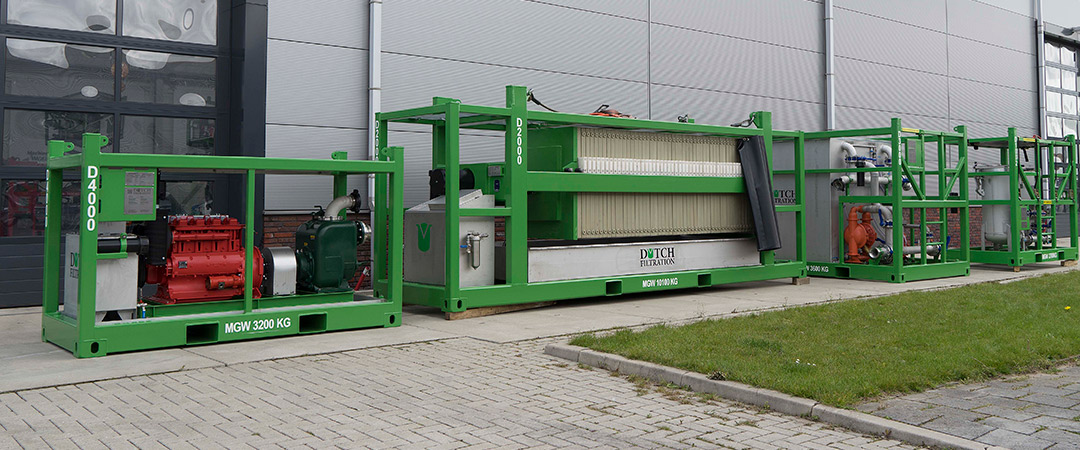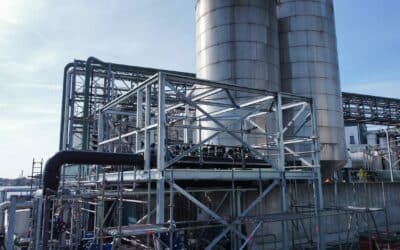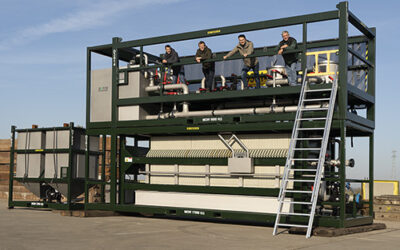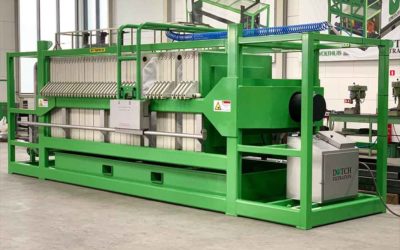Filtration of Oil and Gas Well Completion Fluids
With oil and gas reserves around the world declining and the energy transition to alternative energy sources increasing, it is vital that oil companies extract as much product as possible from each well. Not only must the amount of hydrocarbon produced be maximised, in a way that is safe for the environment and humans, but it is also crucial that production costs are reduced, reservoir life extended as much as possible and hydrocarbon recovery optimised.
Completion fluids play a vital role in the productivity of oil and gas wells. The use of completion fluids facilitates final operations before production starts, can increase well capacity, alleviates problems with well repair, and facilitates cleaning and shutdown of the well when the time is right.
Completion Fluids
Completion fluids could in theory be any fluid that has the proper density and flow characteristics required for the job. However, completion fluids are typically specially prepared brines (concentrated salt solutions) also known as well bore clean out fluids, work over fluids. They are formulated for the particular job by specialized chemical manufacturers and comprise chlorides, bromides and formates (a class of salts made from the neutralization of formic acid).
The completion fluid should be chemically compatible with the reservoir formation (a general term for the rock around the borehole). Matching the density, flow and pH content to the unique characteristics of the well will lengthen the life of the well production zone.
Formulation, manufacturing and selection of the right completion fluid for a particular well is a skilled activity. Fluids can be bought ready for the job or custom made to meet specific needs. It is often believed that in the oil and gas industry a custom made completion fluid, while initially an additional cost, will save money and increase production in the medium to long term, paying for itself throughout the production life of the well.
The useful life and efficiency of completion fluids can be extended by ensuring that they are clean and solids free – this can be effectively achieved by filtration.
Why Filter Completion Fluids
Any solids and contaminates in the completion fluid will reduce its effectiveness and an efficiently filtered and completely solid free completion fluid will add to both the productivity and the dependability of a well over the long term.
Filtration provides clean fluids that will prevent damage to the formation, the reservoir and its ability to transmit fluids (its permeability or measurement of the formation ability to transmit fluids). It does this by the removal of solids and particulates from the fluid that may otherwise block the open space within the rock formation that holds the hydrocarbon fluid (known as porosity) within the production zone.
Applications and purpose of brines
Filtration of a completion fluid is necessary during:
Initial displacement of drilling fluid
A fluid used to force another fluid or cement slurry out of the well borehole casing into the surrounding area known as the annulus.
After and during perforation wash
A cleaning process carried out after holes (perforations) are made in the well bore casing or liner to achieve efficient ‘communication’ between the reservoir and the wellbore.
During gravel pack procedures
This is a control method used to prevent production of formation sand. The primary objective is to stabilize the formation while causing minimal impairment to well productivity.
During underreaming or drill out of cement
Processes carried out to enlarge a wellbore past its original drilled size or during maintenance operations.
Circulating of final inhibitors and additives
Chemical agents added to fluids to slow or prevent an undesirable reaction occurring within the fluid or to other materials in the surrounding environment.
Any circulation of the well
A process of pumping fluid through the whole active well bore and surface fluid system.
Filtered fluid for trip displacement, pills and pill spotting volumes
Specialist fluids used to carry out specific tasks at different times during the drilling and well completion process. Such procedures are to help lift cuttings out of a vertical wellbore, to dissolve invasive salt formations, to destroy caking/coating and relieve differential sticking forces and lost circulation, and to free a differentially stuck drill pipe.
During the use of any new mixed brines
In all of these applications clean solids-free fluids are absolutely necessary if the oil or gas well borehole, the surrounding formation and production zone are to be maintained in a clean and efficient condition. The removal of solids and particulates from the brines and completion fluids ensures oil and gas well productivity.
Requirements for Filtration of Completion Fluids
Requirements for filtration of completion fluids are demanding due to the varied nature of the process and the solids/debris encountered within the fluid during its process cycle.
The following are the primary considerations to address when installing a completion fluid filtration system:
- Typically the filtration should achieve a removal of solids depending on the formation and well bore hole requirements of 1- 10 micron with an absolute efficiency of greater than Beta5000 (a filtration efficiency of 99.98% removal of solids at the micron rating or the system).
- The system should produce low suspended solids in the filtered fluid of < 50 NTU to <10 NTU (Nephelometric Turbidity Units – a system for the measurement of suspended particulates in a liquid or gas colloid).
- It should be capable of handling high flow rates up to 4 – 35 BPM (Barrels Per Minute).
- A wide range of solid particulate sizes should be removed.
- Offshore proof of the systems integrity and operational capabilities should be determined before installation.
- The filtration system should be able of treating very high dirt loads often found in completion fluids up to 1%.
- Fluids have a Specific Gravity (SG) up to 22PPG (pounds-per-gallon) and therefore have a natural resistance to flow that the filtration system must be designed for.
- The filtration system should be simple and robust enough to handle the harsh operational and environmental conditions of the installation.
- Above all it should be economic to run and maintain
Filtration Best Practice
Because there are a number of different completion fluids used over the life of an oil or gas well, each with different characteristics, the filtration system must be able to cope with this variation.
The well completion fluid filtration system must be designed to cope with a relatively high level of solids in a wide range of particle sizes, as well as handle high flow rates and fast throughputs during ongoing operation.
A number of filtration technologies are available for the filtration of completion fluids. These include:
- Dual Vessel Cartridge Filter Units – Cartridge filtration
- Dual Vessel Bag / Cartridge Filter Units
- Filter Press (FP) with Slurry Mixing Skid and Dual vessel Cartridge Filter
- Vertical Pressure Leaf Filters (VPL) with Dual Vessel Cartridge Filters
Filter Press (FP) Technology
Filter Press (FP) systems have been adopted globally for many years as the conventional method of filtration of completion fluids in the oil and gas field industry.
A Typical Dutch Filtration FP system 1200 sq.ft.
FP systems use a series of sealed filter plates with inside a permeable filter cloth. All the plates are clamped together in a vertical orientation by a hydraulic cylinder. All the plates will create filtration chambers which holds the filter cake (DE-media) and the captured dirt particles.
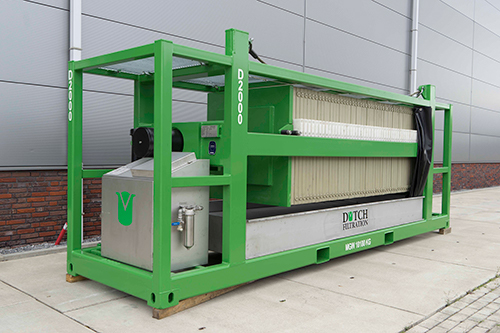
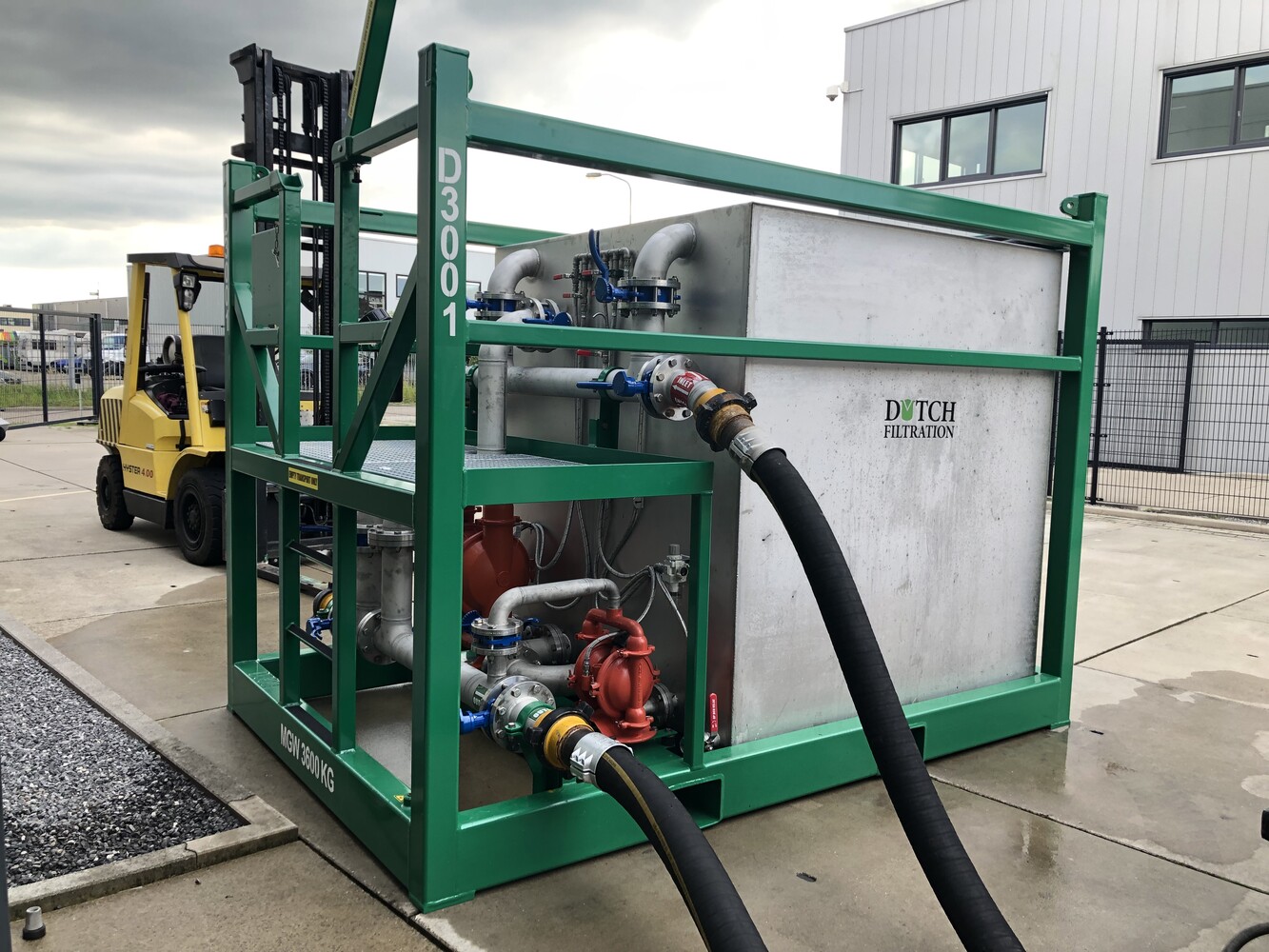
A Typical Dutch Filtration dual slurry mixing skid.
FP systems are ally supplied with a slurry mixing skid to mix and add filter aid called Diatomaceous Earth [DE] to the system. The slurry skid is equipped with an air driven diaphragm pump for pre-coating and body-feed for the DE. This unit has two mix tanks (16 BBL/each),
Together with a Dual Vessel cartridge filter unit downstream this arrangement of FP and Slurry Skid forms the best reliable solution to the filtration of heavy completion fluids with rates up to 35 BPM.
A Typical Dutch Filtration VPL system
VPL systems use a series of vertical pressure leaf’s made from a self-supporting stainless steel mesh covered by heavy duty polypropylene cloth. Filter aid is introduced via a mixing tank using an air driven diaphragm pump for pre-coating and body-feed of the diatomaceous earth.
Final polish of the fluid is carried out using a Dual Vessel Cartridge Filter that uses glass fibre absolute pleated cartridges. This system provides a highly efficient and reliable solution for the filtration of completion fluids.
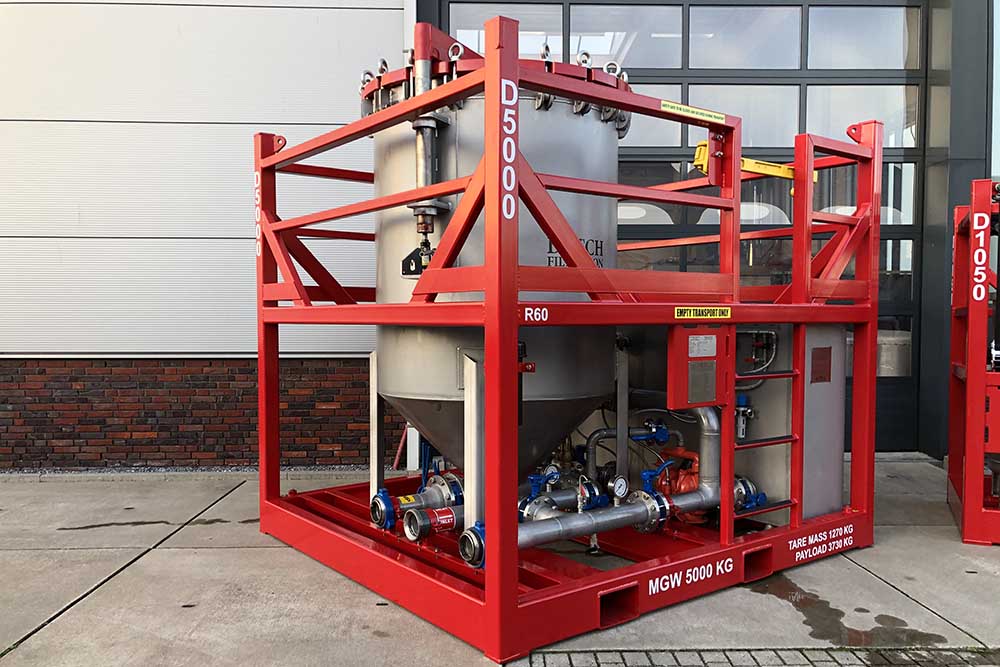
Diatomaceous Earth Filtration
Diatomaceous Earth [DE] is a naturally occurring, siliceous sedimentary rock formed from the fossilized skeletal remains of diatoms, a type of microscopic hard-shelled algae. They have a particle size ranging from less than 1 micron to more than 1 millimeter, but typically between 10 to 200 microns. Diatomaceous Earth is used as a filter aid to improve filtration efficiency and extend the life of the filtration system.
In both FP and VPL systems prior to running a filtration duty, the filter aid, Diatomaceous Earth is introduced into the system where it is circulated until a filter cake builds up on the surface of either the filter media of the FP or the stainless settle mesh grid of the VPL filter.

Principles of Diatomaceous Earth Filtration
This is often done in two phases called the pre-coat and body coat. This combination of pre-coat and body feed ensures that the filter cake of DE remains porous and performs its filtration duty. In effect, because the cake of DE is a non-compressible micro porous structure, it acts as the ideal filtration medium for the removal of high volumes of solids.
Once the cake has developed the filtration system is brought online to carry out its filtration duty.
Filter Press (FP) Operation
Prior to start filtration of dirty fluids the Press filter unit must have a pre-coat of Diatomaceous Earth [DE] filter aid. During filtration of the dirty brines DE is added continuously (body feed).
The DE is held in stainless steel tank with an air agitator for homogeneous mixing within a unit called the slurry mixing skid. It is then fed with an air driven diaphragm pump into the FP unit and circulated back to the mixing unit; here it is progressively removed from the fluid flow until a cake is built up on the filter cloth inside the FP unit to form a pre-coat. This process is also known as precoating. Once the pre-coat layer of DE has built up, another low dose of DE is introduced to the system known as the body feed together with the dirty fluid. The body feed of DE keeps the filter cake porous and extend the lifetime of the filtration cycles.
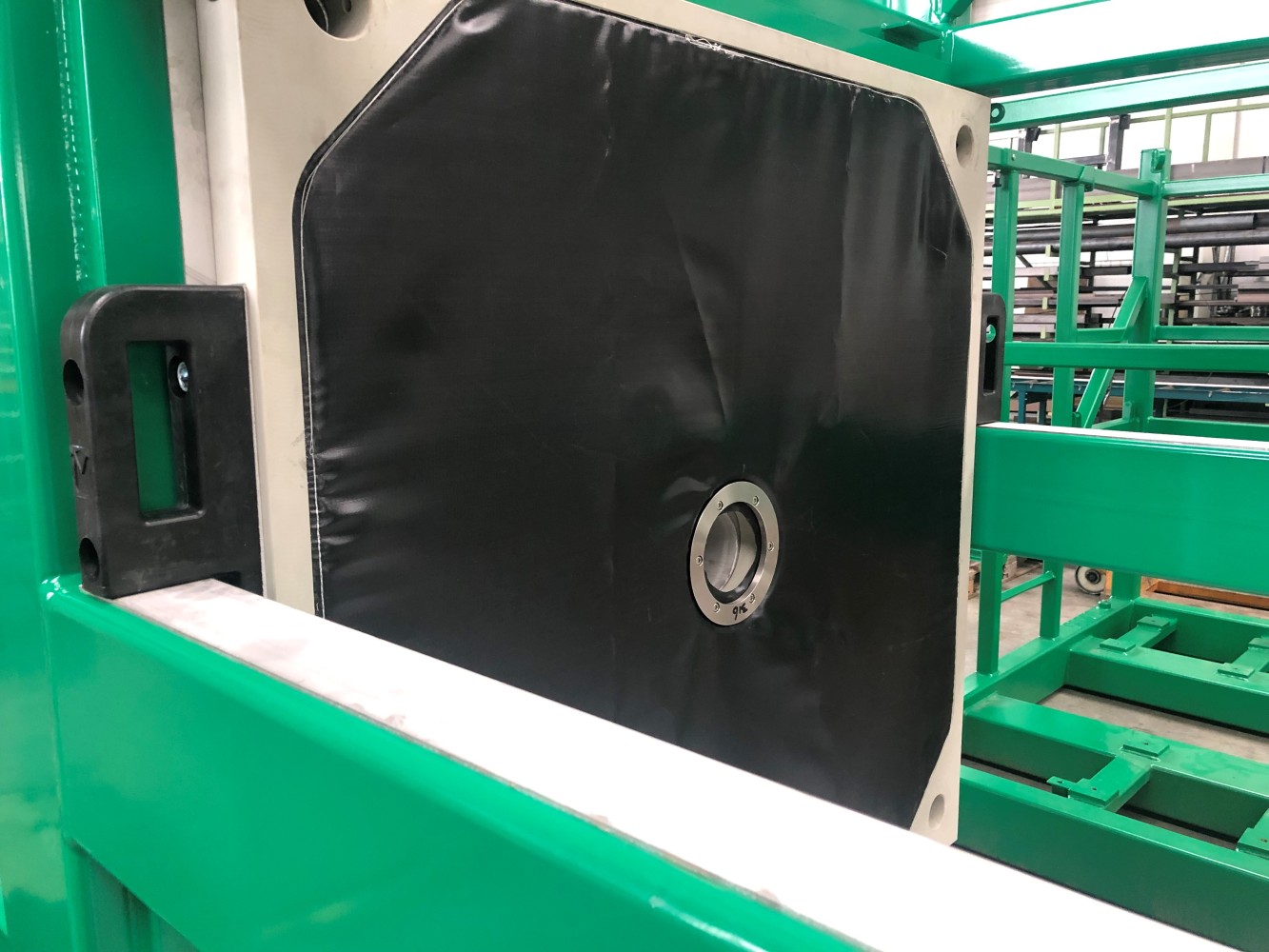
Over time, as solids are removed by the filter press and captured in the chamber with the filter cake of DE, a loss of flow occurs and the differential pressure (knows and Delta P, dP or ∆P) builds up across the filter system. Eventually the through put is too low, when this happens, the filter needs to be cleaned.
Cleaning can only be achieved by taking the FP out of service and manually cleaning the plate for plate, DE and removed solids which are then disposed off. Then a new pre-coat procedure needs to be carried out before filtration of the dirty brines can start. New filter presses can be equipped with a semi-automatic plate shifter. One operator can shift and clean all the filter plates without physically touching the plates.

Filter press with plate shifter for safe, quick and easy cleaning of a filter press.
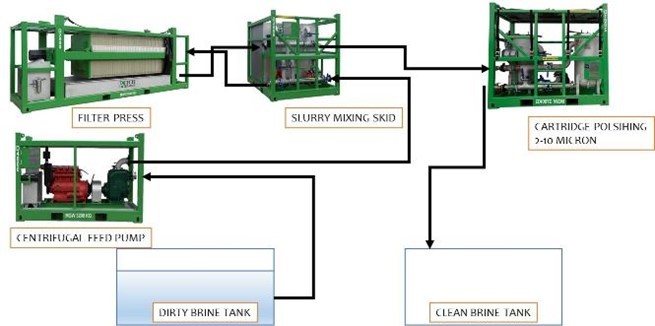
Typical Filter Press (FP), Slurry Skid and Dual Vessel Filtration System
Fluid from the Clean Brine Tank is fed into the Well, after use and prior to filtration is it sent to a Dirty Brine Tank where a robust Self-priming Pump then transfers it to the filter press unit which removes the bulk solids and contamination. Downstream of the FP system the fluid is passed through a Dual Vessel Cartridge Filter Unit where a final polish and cleaning of the fluid is carried out prior to retuning it to the Clean Brine Tank for re-use in the Well.
Features of a FP system:
- Requires manually cleaning, optional: semi-automatic plate shifter
- Large Filter area up to 2500 sq.ft. per filter press
- High flow design with 1500×1500 plates for safe handling, 6 inch manifold
- Pneumatic – Hydraulic Operated
- Robust and reliable design
- All wetted parts stainless steel and polypropylene
- Filter Press system consists always minimum two skids. Filter Press and slurry mixing skid
Smaller footprint solutions
Cause of the large footprint of the filter press and the mixing slurry skid. The special designed stackable mixing skid with a dual cartridge filter can be placed on top of the filter press which significantly reduces the footprint of the filter spread. This stackable design has space to work safely on top of the filter press. Adding DE media and change our cartridges.
Filter Press with stackable slurry skid – dual cartridge filter unit
Vertical Pressure Leaf Filters (VPL) Operation
Like the FP filter, the VPL filter unit must have a pre-coat and body coat of Diatomaceous Earth [DE] prior to carrying out its filtration duty.
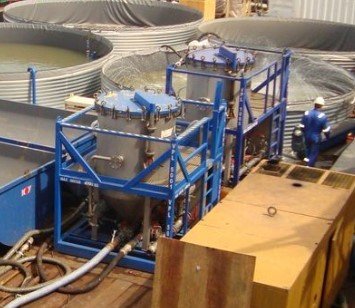
Two Vertical Pressure Leaf Unit onsite in parallel for continuous operation
Initially the DE is held in a mix tank that is mixed by using compressed air to agitate. It is then fed into the Vertical Pressure Leaf filter vessel and circulated; here the DE is progressively removed from the fluid flow until a cake is built up on the surface of the filter leaves (stainless steel leaves with polypropylene filter cloth) inside the VPL unit to form a pre-coat.
Once the pre-coat layer of DE has built up on the vertical pressure filter leaves, the dirty brines can be pumped into the filter with a low continuous dose of DE is introduced to the system known as the body feed.
This combination of pre-coat and body coat is the most effective filtration medium for the removal of high volumes of solids. This makes the VPL/DE and Dual Vessel Filter system an ideal solution for high flow rate and throughout applications allowing the system to cope with the demands of high speed processing where continuity of filtration is important.
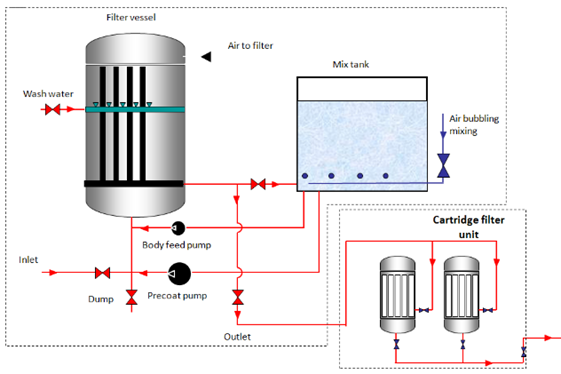
Flow diagram Vertical Pressure Leaf (VPL) DE and Dual Vessel Filter
Over time, flow rate reduces as solids are removed by the VPL filter and the differential pressure [dP] builds up across the filter system. Eventually the fluid flow is reduced, when this happens, the filter needs to be cleaned (wash down).
The advantage of the VPL system is that cleaning can be achieved by a semi-automatic process where a high pressure water wash-down system cleans the vertical pressure leaves. Used DE and the removed solids are disposed through the dump line and a new pre-coat of DE will be applied. The VPL filter is then brought back into service with this process taking approximately 15 minutes.
Vertical Pressure Leaf vs Filter Press
Each filtration system has its unique application in a particular field of work. Important is the lifetime of a filtration cycle with the pressure difference and the time of cleaning.
When comparing Vertical Pressure Leaf (VPL) DE over conventional Filter Press plate (FP) systems of the same size unit the FP system has less effective flow area compared to the VPL/DE system which has a massive 90% effective flow area available for filtration duties. This is due to the need to intimately support the filtration media within the FP system compared to the robust, self-supporting structure of the leaves in the VPL filter. This is why the most common size filter press is 1200sq.ft. and VPL is 600sq.ft.
In most operations the filter press with 1200 sq.ft. is the standard, this size of press can handle almost all fluids and is easy to operate and has a cake capacity of 1500ltrs. Whereas a VPL need to clean at max 4 bar dP a filter press will go up to the maximum of 7 bar differential. Actually, the denser the filter cake in the filter press, the easier the release of filter cake. In general, VPL are used for light brines and small footprints, filter press is used for more heavy fluids.
Typical VPL/DE and Dual Vessel Filter Installation
A typical closed loop Completion Fluid Filtration System comprises all of the required equipment for brine storage, pumping and filtration.
Fluid from the Clean Brine Tank is fed into the Well, after use and prior to filtration is it sent to a Dirty Brine Tank where a robust Self-priming Pump then transfers it to the VPL/DE filtration system which removes the bulk solids and contamination. Downstream of the VPL/DE system the fluid is passed through a Dual Vessel Cartridge Filter Unit where a final polish and cleaning of the fluid is carried out prior to retuning it to the Clean Brine Tank for re-use in the Well.
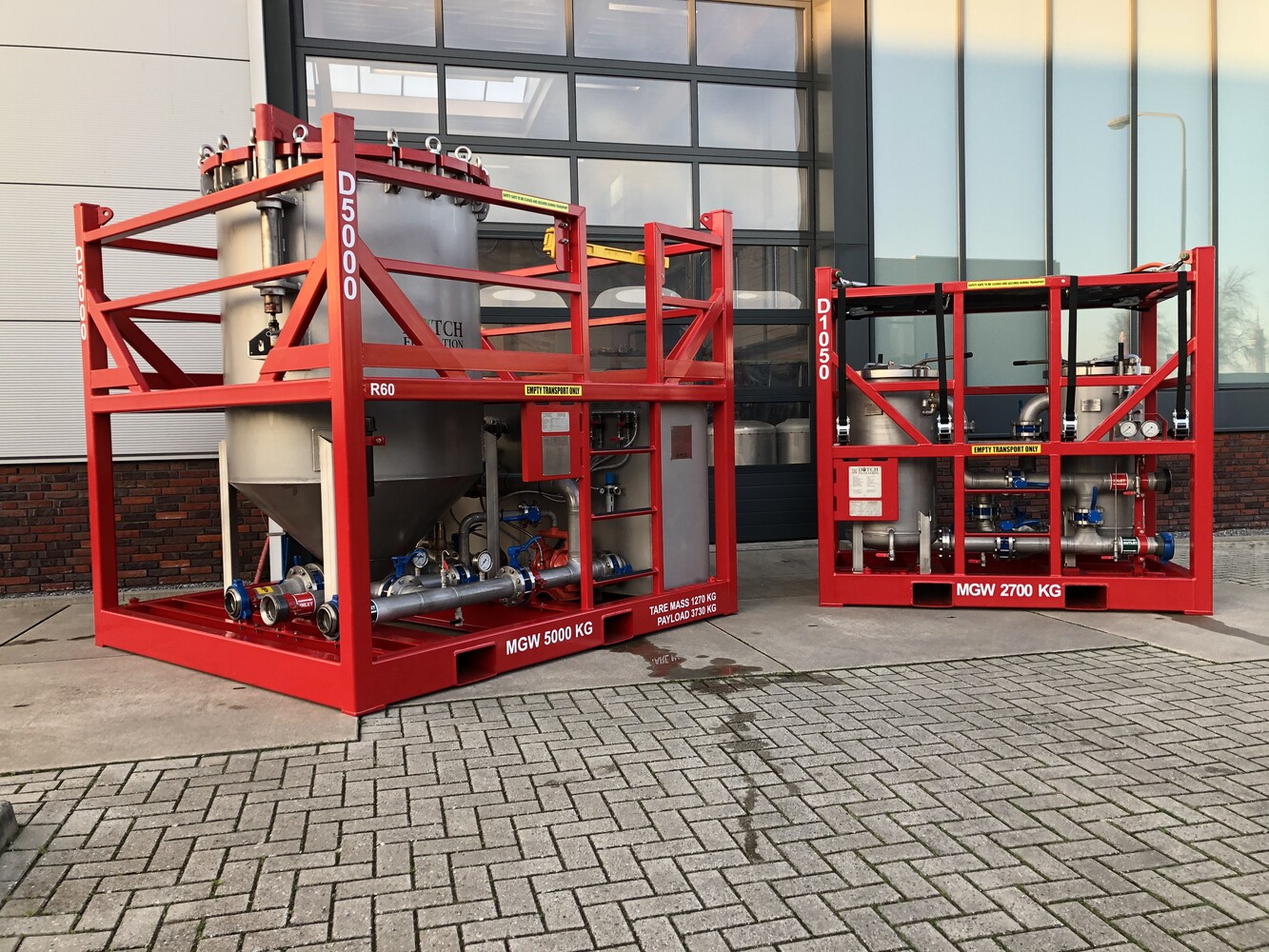
Dual Vessel Cartridge Filtration System
A dual cartridge filter system is the most common filter unit present at an oil drilling site or mud plant. It is always used to polish the fluid after a filter press or a vertical pressure leaf. Usually this is a 2 or 5 micron filter cartridge. But also for small amounts of fluids often only the dual cartridge filter unit is used because of its great flexibility and small footprint. These twin pod units can be applied with filter bags and/or filter cartridges, in a range from a few mm up to 0.5 micron. The possibility of different filter elements always gives the user the choice of the most economical solution for a particular filter job. The two filter housings in parallel give the possibility of continuous filtration. In other words, filtration over one housing and changing the elements of the second housing. The manifold with 6 valves gives the flexibility to quickly switch over, use the by-pass or even use both filter vessels in series.
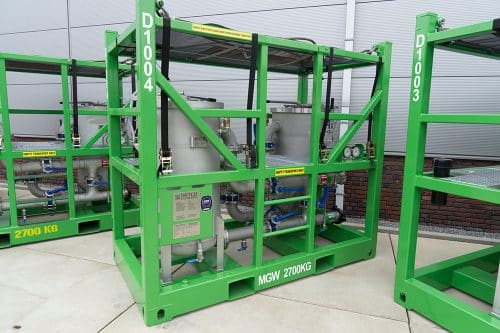
Typical Framed Skid Mounted Dual Vessel Cartridge Filter
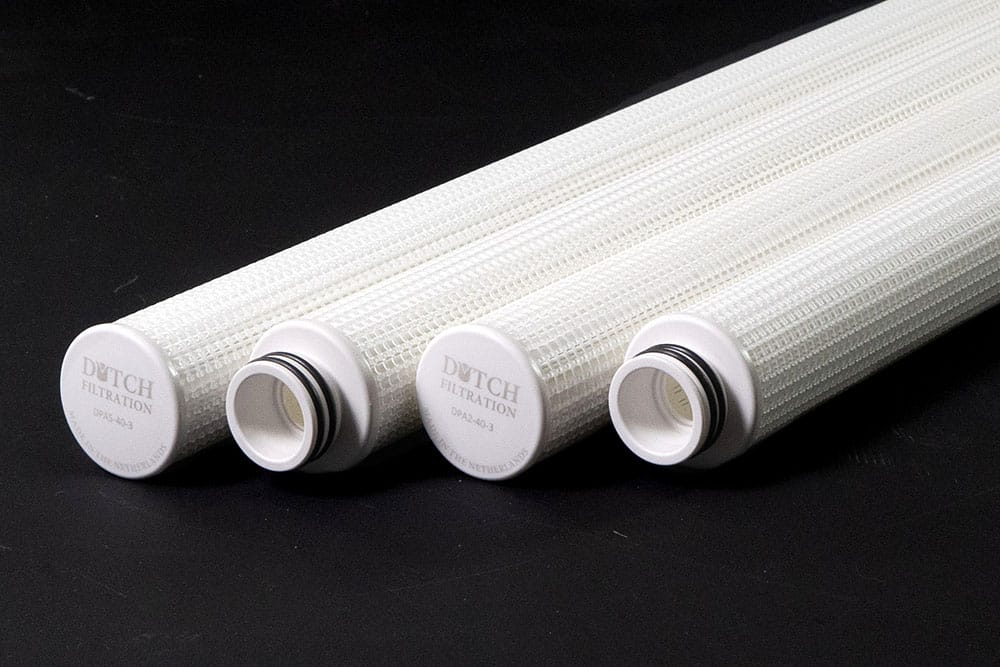
Pleated Filter Cartridge
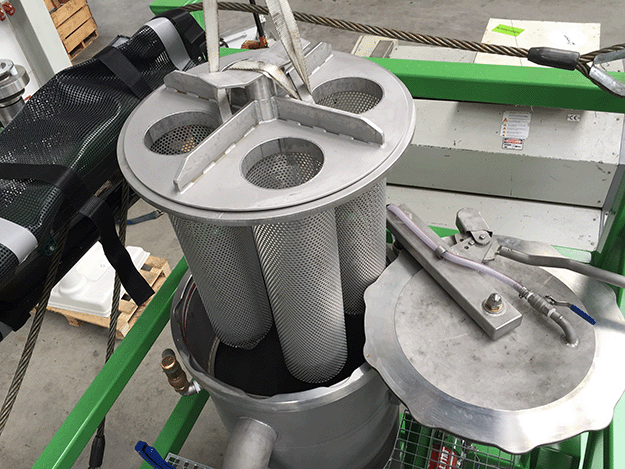
Dual Vessel Unit with Conversion Kit to Filter Bags
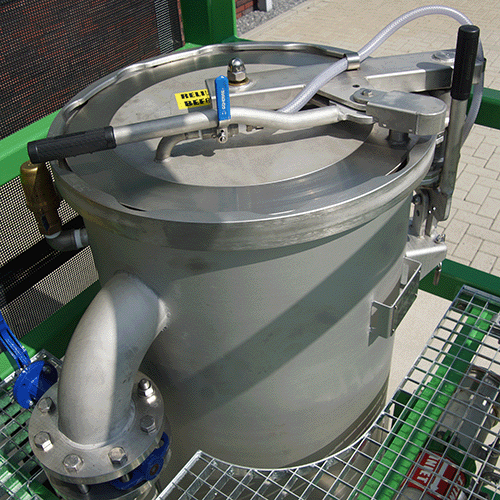
Rudi Quick Opening Closure
Quick and safe changing the filter cartridges or bags, we have 2 options:
- The standard swing bolt closure. Here the swing bolts of the filter housing are all loosened with tools after which the cover lid can be opened with a davit and turned away. The same to close but in the opposite order.
- Quick Release or Quick Opening Closure (Rudi type). This makes it possible to open (and close) the filter housing in a few seconds after the pressure has been released, without using tools.
All wetted parts of the filter unit are made of stainless steel 316 to be corrosion resistant against the aggressive fluids. It is always used to polish the fluid after a filter press or a vertical pressure leaf. Usually this is a 2 or 5 micron filter. But also for small amounts of fluids often only the dual cartridge filter unit is used because of its great flexibility and small footprint. These units can be applied with filter bags and/or filter elements, in a range from a few mm up to 0.5 micron. The possibility of different filter elements always gives the user the choice of the most economical solution for a particular filter job. The two filter houses in parallel give the possibility of continuous filtration. In other words, filtration over one housing and changing the elements of the second housing. The manifold with 6 valves gives the flexibility to quickly switch over, use the by-pass or even use both filter houses in series.
To replace the element quickly and safely we have 2 options.
- Standard swing bolt closure. Here the bolts of the filter housing are all loosened with tools after which the cover or lid can be opened with a davit and turned away. The same to close but in the opposite order.
- Quick Opening Closure / Quick Release . This makes it possible to open (and close) the filter housing in a few seconds after the pressure has been released, without using tools. So no change of operators forgetting tools on top of the unit and have the risk of dropping objects.
All wetted parts of the filter unit are made of stainless steel 316 to be corrosion resistant against the aggressive liquids.
The frame is designed, built and certified to ISO10855/DNV2.7-1/EN12079. Equipped with forklift pockets and a lifting sling, this unit can be deployed quickly and easily. For many different filtration applications.
Typical System Requirements
Each Completion Fluid Filtration system needs to be designed to meet the needs of the actual well, its surrounding formation and the specific fluid being used. Having said this, there are some general requirements that are true for all such systems.
Typical system requirements will include the need for overall filtration capability to remove the maximum volume of solid contaminants with a high flow rate/throughput. The system should offer an easy to operate cleaning procedure system and filter cartridge replacement procedure. Safety of operators is also a major consideration and adequate safety railings and work platforms should be an integral part of the overall design.
The advantages of a closed loop system ensure that spillages and any potential pollution of the surrounding work area and local environment are minimized.
System control required for the precoat and body feed operations, pumping and recirculation procedures, filter cartridge removal, maintenance and operation control should all be able to be carried out from one easy to manage and operate control panel. Pumps and compressors should be able to use the existing services such as being diesel driven, electric powered or air actuated.
The design of the pressure vessels needs to comply with international standards to ensure that the vessels are designed and constructed to the appropriate standards to handle high pressures and operational requirements. Because of the aggressive nature of the fluids being filtered it is best to ensure that all wetted parts are made from 316L stainless steel which ensures that then equipment offers a good service life.
Small footprint designs utilising framed and skid mounted units make transportation to site/location and installation easier. They also save on valuable space and make it simpler to integrate them into the overall scheme of the well bore and surface fluid system.
Safe DE Handling
Diatomaceous Earth as filter aid has proven to be the most effective media for filtration of oilfield brines.
The most used packing for DE is the 50 lbs. paper bag. These bags are cut and poured into the mix tank. The operator and his surrounding are exposed to the fine silica particles and therefore the need of breathing masks are necessary.
DE dosing system allow dust free DE dosing into the mix tank of the slurry skid prior to feed the filter press.
The system contains a framed holding hopper tank with big bag of DE and an air driven powder pump (framed), max 20 m feed hose and dosing manifold to place onto the mix skid.
The DE-media will arrive on the rig in big-bags. The big bag will be hooked to the lid of the hopper tank. This will be lifting into the hopper tank. The big bag can be opened at the bottom through a side door of the hopper tank. The powder pump, which is mounted into a protecting cage, will pump the DE from the hopper tank to the dosing manifold with venturi on the mix tanks.
Benefits
- Dust free dosing DE – health and environmentally friendly
- No manual lifting of DE 50 lbs. bags
- Semi automatic DE dosing

Dual DE Hopper Tank (DNV2.7-1) with powder pump
Comparison filtration solutions
| Pro | Cons | |
|---|---|---|
| Dual Vessel Unit with Cartridges | * Small batches fluids * Simple to operate * Small footprint | * Not suitable for large batches * Not suitable for heavy contaminated fluids * High OPEX |
| Vertical Pressure Leaf with Dual Cartridge Filterunit | * For light and medium weight brines * Small footprint * Low OPEX * Quick wash down DE filter | * More experienced operator required * Not suitable for heavy fluids * Clean out at max dp 4 bar |
| Filterpress with Dual Slurry Skid and Dual Cartridge Filterunit | * For medium and heavy brines * Heavy duty construction * Low OPEX | * Manual cleaning * Long wash down time * Large footprint |
| Filterpress with Stackable Dual Slurry Skid and Dual Cartridge Filter Unit | * For medium and heavy brines * Low OPEX * Small footprint/stackable * Heavy duty construction * High Flow design available up to 32BPM * Easy rig up | * Manual cleaning * Long wash down time |
Conclusion
Clean fluids or brine are required for effective completion of a well bore. This will result in maximum production of oil and gas. This filtration of the completion fluids must be carried out according to the highest safety and environmental standards, in a fast and cost-effective manner. The most appropriate way for this filtration is Vertical Pressure Leaf filters (VPL) or filter presses (FP) with Dual Vessel Cartridge Filters with the corresponding absolute rated filter cartridges.
Filter Press is robust and simple in operation but requires manual operation. VPL is more advanced, closed system, small footprint, semi-automatic and designed for lighter fluids. Filter Press is more for heavier fluids and higher rates, what you see is what you get.
The dual vessel cartridge filter units with Rudi Quick Opening Closure allows the operator to open and closure the filter vessel safe and quick in a few seconds without using any tools.
A successful well bore completion with clean liquids is, in addition to proper and well maintained filtration equipment and filter consumables, in the hands of well-trained filtration operators.

